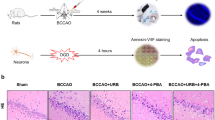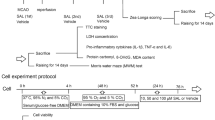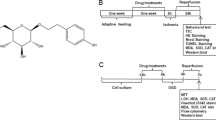Abstract
Endoplasmic reticulum stress is an important contributor to the cerebral ischemic injury. Sappanone A (SA), a kind of natural homoisoflavanone extracted from Caesalpinia sappan L, has been evidenced to exhibit anti-inflammatory and antioxidative properties. The present study aimed to investigate the potential neuroprotective effects of SA in cerebral ischemia-reperfusion injury. The potential neuroprotective effect of SA was tested in a rat model of middle cerebral artery occlusion (MCAO) allowing reperfusion and PC12 cell model of oxygen-glucose deprivation and reperfusion (OGD/R). Post-ischemic neuronal injury was evaluated by 2, 3, 5-triphenyltetrazolium chloride (TTC) and hematoxylin-eosin (H&E) staining. The levels of inflammatory factors and oxidative stress-related markers were detected using corresponding kits. Cell apoptosis was evaluated by terminal deoxynucleotidyl transferase dUTP nick end labeling (TUNEL) or flow cytometry, and the expression of apoptosis-associated proteins was determined using western blot analysis. Subsequently, endoplasmic reticulum stress-related proteins were detected through western blot analysis, and CCAAT/enhancer binding protein (C/EBP) homologous protein (CHOP) was overexpressed to confirm the contribution of endoplasmic reticulum stress inhibition by SA to the neuroprotective effects post OGD/R. Results revealed that SA was effective in ameliorating cerebral infarction and pathological injuries post-reperfusion following MCAO, which is associated with reduced inflammation, oxidative stress, and cell apoptosis by SA in the brain. Consistently, these neuroprotective effects of SA post ischemia-reperfusion were also observed in a PC12 cell model of OGD/R. Importantly, endoplasmic reticulum stressors, including the CHOP, the 78 kDa glucose-regulated protein 78 (GRP78), and phosphorylated eukaryotic initiation factors 2α (EIF-2α), were significantly downregulated by SA, while CHOP overexpression attenuated the beneficial effects of SA on inflammation, oxidative stress, and apoptosis in OGD/R-induced PC12 cells. These results demonstrated that SA alleviates endoplasmic reticulum stress, ameliorating inflammation, oxidative stress, and apoptosis, and thereby serves as therapeutic potential for protection against cerebral ischemia-reperfusion injury in ischemic stroke.






Similar content being viewed by others
Data availability
All data present in the paper is available for reasonable request to the corresponding author.
References
Global, regional, and national age-sex-specific mortality for 282 causes of death in 195 countries and territories, 1980-2017: a systematic analysis for the Global Burden of Disease Study 2017. Lancet. 2018. 392(10159):1736-88.
Global, regional, and national age-sex-specific mortality and life expectancy, 1950-2017: a systematic analysis for the Global Burden of Disease Study 2017. Lancet. 2018. 392(10159):1684-735.
Esenwa, C.C., and M.S. Elkind. 2016. Inflammatory risk factors, biomarkers and associated therapy in ischaemic stroke. Nat Rev Neurol. 12 (10): 594–604.
Shi X, Tao G, Ji L, Tian G. Sappanone A alleviates hypoxia/reoxygenation-induced cardiomyocytes injury through inhibition of mitochondrial apoptosis and activation of PI3K-Akt-Gsk-3beta pathway. Biosci Rep. 2020. 40(2).
Gong, D.J., L. Wang, Y.Y. Yang, J.J. Zhang, and X.H. Liu. 2019. Diabetes aggravates renal ischemia and reperfusion injury in rats by exacerbating oxidative stress, inflammation, and apoptosis. Ren Fail. 41 (1): 750–761.
Xu, B., Y. Qin, D. Li, N. Cai, J. Wu, L. Jiang, L. Jie, Z. Zhou, J. Xu, and H. Wang. 2020. Inhibition of PDE4 protects neurons against oxygen-glucose deprivation-induced endoplasmic reticulum stress through activation of the Nrf-2/HO-1 pathway. Redox Biol. 28: 101342.
Han, J., R. Murthy, B. Wood, B. Song, S. Wang, B. Sun, H. Malhi, and R.J. Kaufman. 2013. ER stress signalling through eIF2alpha and CHOP, but not IRE1alpha, attenuates adipogenesis in mice. Diabetologia. 56 (4): 911–924.
Leitman, J., B. Barak, R. Benyair, M. Shenkman, U. Ashery, F.U. Hartl, and G.Z. Lederkremer. 2014. ER stress-induced eIF2-alpha phosphorylation underlies sensitivity of striatal neurons to pathogenic huntingtin. Plos One. 9 (3): e90803.
Chern, Y.J., J. Wong, G. Cheng, A. Yu, Y. Yin, D.F. Schaeffer, et al. 2019. The interaction between SPARC and GRP78 interferes with ER stress signaling and potentiates apoptosis via PERK/eIF2alpha and IRE1alpha/XBP-1 in colorectal cancer. Cell Death Dis. 10 (7): 504.
Shi, X., G. Tao, L. Ji, and G. Tian. 2020. Sappanone A protects against myocardial ischemia reperfusion injury by modulation of Nrf2. Drug Des Devel Ther. 14: 61–71.
Trotman-Lucas, M., M.E. Kelly, J. Janus, and C.L. Gibson. 2019. Middle cerebral artery occlusion allowing reperfusion via common carotid artery repair in mice. J Vis Exp. 143.
Zhu, J.R., Y.F. Tao, S. Lou, and Z.M. Wu. 2010. Protective effects of ginsenoside Rb(3) on oxygen and glucose deprivation-induced ischemic injury in PC12 cells. Acta Pharmacol Sin. 31 (3): 273–280.
Mizuma, A., J.S. You, and M.A. Yenari. 2018. Targeting reperfusion injury in the age of mechanical thrombectomy. Stroke. 49 (7): 1796–1802.
Wood, H. 2018. Selective neuronal loss could limit penumbral rescue after stroke. Nat Rev Neurol. 14 (7): 380–381.
Li X, Ren Z, Wu Z, Fu Z, Xie H, Deng L, et al. Steric effect of antioxidant Diels-Alder-type adducts: a comparison of Sanggenon C with Sanggenon D. Molecules. 2018. 23(10).
Zelova, H., Z. Hanakova, Z. Cermakova, K. Smejkal, A.S. Dall, P. Babula, et al. 2014. Evaluation of anti-inflammatory activity of prenylated substances isolated from Morus alba and Morus nigra. J Nat Prod. 77 (6): 1297–1303.
Martel, J., D.M. Ojcius, C.J. Chang, C.S. Lin, C.C. Lu, Y.F. Ko, S.F. Tseng, H.C. Lai, and J.D. Young. 2017. Anti-obesogenic and antidiabetic effects of plants and mushrooms. Nat Rev Endocrinol. 13 (3): 149–160.
Stoll, G., and B. Nieswandt. 2019. Thrombo-inflammation in acute ischaemic stroke - implications for treatment. Nat Rev Neurol. 15 (8): 473–481.
Flemming, A. 2019. Calming inflammation to prevent stroke damage. Nat Rev Immunol. 19 (8): 473.
Liu, Q., E.M. Johnson, R.K. Lam, Q. Wang, Y.H. Bo, E.N. Wilson, et al. 2019. Peripheral TREM1 responses to brain and intestinal immunogens amplify stroke severity. Nat Immunol. 20 (8): 1023–1034.
Lee, S., S.Y. Choi, Y.Y. Choo, O. Kim, P.T. Tran, C.T. Dao, B.S. Min, and J.H. Lee. 2015. Sappanone A exhibits anti-inflammatory effects via modulation of Nrf2 and NF-kappaB. Int Immunopharmacol. 28 (1): 328–336.
Choo, Y., P.T. Tran, B. Min, O. Kim, H.D. Nguyen, S. Kwon, et al. 2017. Sappanone A inhibits RANKL-induced osteoclastogenesis in BMMs and prevents inflammation-mediated bone loss. Int Immunopharmacol. 52: 230–237.
Rodrigo, R., R. Fernandez-Gajardo, R. Gutierrez, J.M. Matamala, R. Carrasco, A. Miranda-Merchak, and W. Feuerhake. 2013. Oxidative stress and pathophysiology of ischemic stroke: novel therapeutic opportunities. CNS Neurol Disord Drug Targets. 12 (5): 698–714.
Li, P., R.A. Stetler, R.K. Leak, Y. Shi, Y. Li, W. Yu, et al. 2018. Oxidative stress and DNA damage after cerebral ischemia: potential therapeutic targets to repair the genome and improve stroke recovery. Neuropharmacology 134 (Pt B): 208–217.
Kang, C., J. Gao, M. Kang, X. Liu, Y. Fu, and L. Wang. 2019. Sappanone A prevents hypoxia-induced injury in PC12 cells by down-regulation of miR-15a. Int J Biol Macromol. 123: 35–41.
Zeeshan, H.M., G.H. Lee, H.R. Kim, and H.J. Chae. 2016. Endoplasmic reticulum stress and associated ROS. Int J Mol Sci. 17 (3): 327.
Hong, J., K. Kim, J.H. Kim, and Y. Park. 2017. The role of endoplasmic reticulum stress in cardiovascular disease and exercise. Int J Vasc Med. 2017: 2049217.
Xin, Q., B. Ji, B. Cheng, C. Wang, H. Liu, X. Chen, J. Chen, and B. Bai. 2014. Endoplasmic reticulum stress in cerebral ischemia. Neurochem Int. 68: 18–27.
Chang, Y.J., Y.P. Huang, Z.L. Li, and C.H. Chen. 2012. GRP78 knockdown enhances apoptosis via the down-regulation of oxidative stress and Akt pathway after epirubicin treatment in colon cancer DLD-1 cells. Plos One. 7 (4): e35123.
Zong, Z.H., Z.X. Du, N. Li, C. Li, Q. Zhang, B.Q. Liu, et al. 2012. Implication of Nrf2 and ATF4 in differential induction of CHOP by proteasome inhibition in thyroid cancer cells. Biochim Biophys Acta. 1823 (8): 1395–1404.
Dauer, P., N.S. Sharma, V.K. Gupta, B. Durden, R. Hadad, S. Banerjee, V. Dudeja, A. Saluja, and S. Banerjee. 2019. ER stress sensor, glucose regulatory protein 78 (GRP78) regulates redox status in pancreatic cancer thereby maintaining “stemness”. Cell Death Dis. 10 (2): 132.
Author information
Authors and Affiliations
Contributions
Meihua Wang and Zhilin Chen designed this study, performed experiments, and interpreted the data. Lei Yang collected the data, searched the literature, and wrote the manuscript. Lei Ding revised the manuscript. All authors read and approval the final manuscript.
Corresponding author
Ethics declarations
Competing interests
The authors declare no competing interests.
Ethics approval and consent to participate
All animal studies were approved by the Animal Care and Use Committee of Huashan Hospital Affiliated to Fudan University.
Consent for publication
Not applicable
Additional information
Publisher’s Note
Springer Nature remains neutral with regard to jurisdictional claims in published maps and institutional affiliations.
Rights and permissions
About this article
Cite this article
Wang, M., Chen, Z., Yang, L. et al. Sappanone A Protects Against Inflammation, Oxidative Stress and Apoptosis in Cerebral Ischemia-Reperfusion Injury by Alleviating Endoplasmic Reticulum Stress. Inflammation 44, 934–945 (2021). https://doi.org/10.1007/s10753-020-01388-6
Received:
Revised:
Accepted:
Published:
Issue Date:
DOI: https://doi.org/10.1007/s10753-020-01388-6




